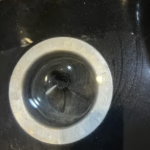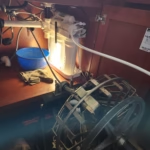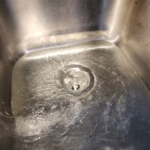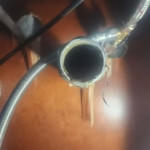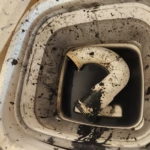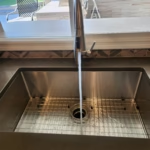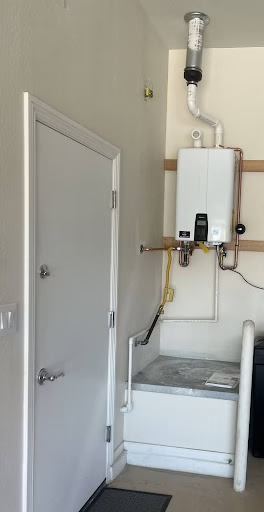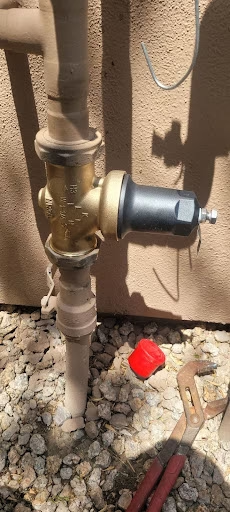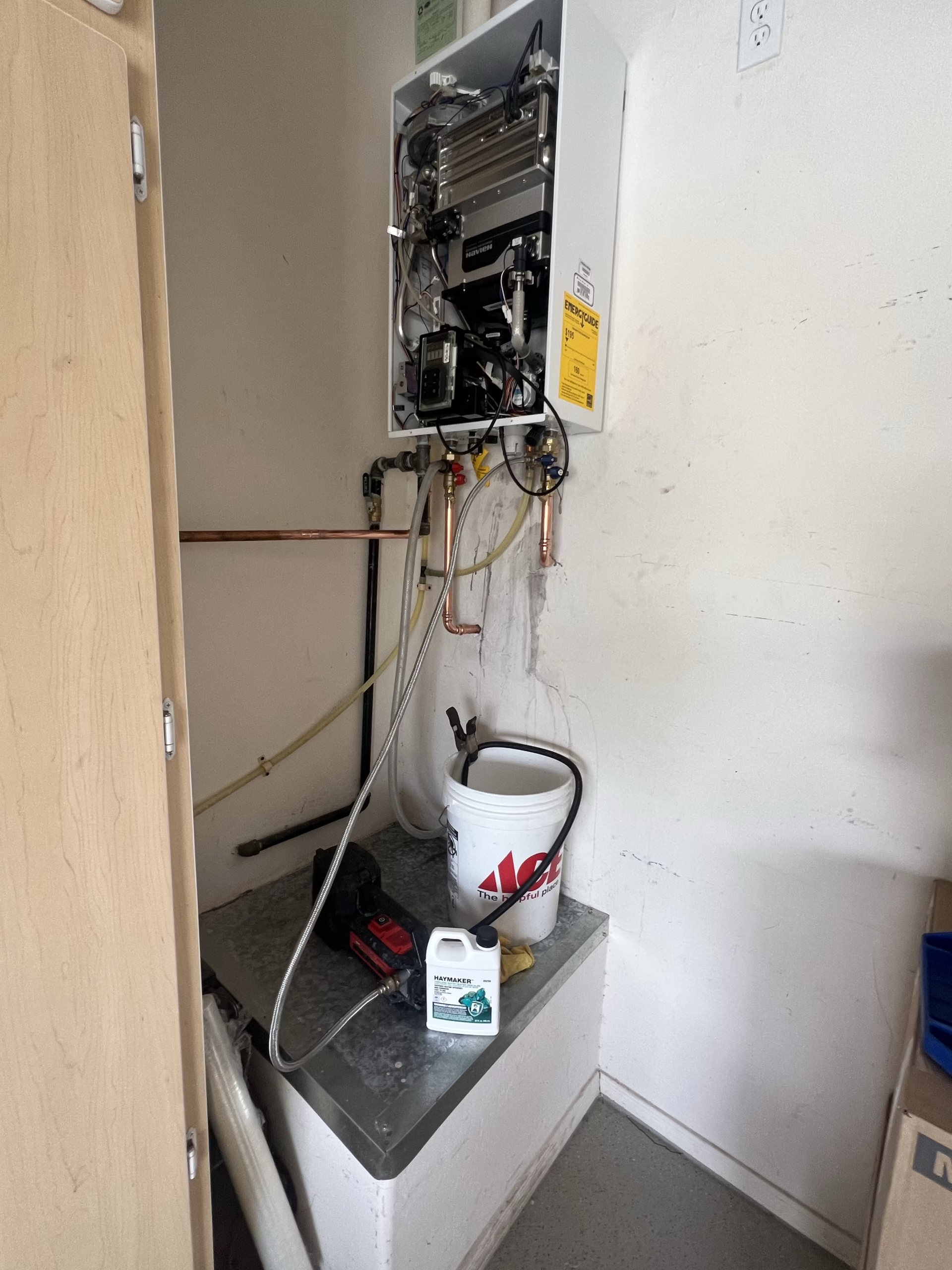Do It Yourself with Simple Fixes for Common Drain Problems!
You’re standing over your kitchen sink, ready to tackle a mountain of dishes, or maybe just wash your hands after cooking. You turn on the faucet, and… nothing. Or worse, the water starts pooling, slowly, disgustingly, around your plates, threatening to overflow onto your freshly cleaned counters. You try to rinse something down, and it just sits there, swirling in a grim vortex of shame.
Sound familiar?
That familiar knot of dread tightens in your stomach. Is it a full-blown clog? Is it going to stink up the whole kitchen? How much is this going to cost? And do you really have time to deal with this right now? You might feel a mix of frustration, a little bit of helplessness, and maybe even a tiny bit of guilt for what might have gone down that drain. You’re not alone. Every homeowner, from Glendale to Chandler, Phoenix to Peoria, has faced the silent torment of a stubborn kitchen sink.
We get it. At Instant Plumbing, we’ve been helping folks across the Valley with their plumbing problems since 2001. We’ve seen every kind of kitchen sink issue imaginable, and we understand that a simple household problem can quickly become a major headache for you. We know you want your home to run smoothly and when a basic necessity like a kitchen sink backs up, it throws your whole day, or even your week, out of whack.
The good news? Not every slow drain or stubborn clog needs an emergency visit from a professional plumber. Many common kitchen sink drain problems are entirely fixable with a bit of know-how, a few simple tools, and a willingness to get your hands dirty. Think of it as empowering yourself to conquer kitchen chaos! This blog is all about giving you the power back, helping you diagnose the problem, and walking you through some straightforward DIY fixes that can save you time, money and a whole lot of frustration.
Let’s get your kitchen sink draining again!
Is Your Kitchen Sink Draining Slowly or Not at All? Identifying Common Clog Culprits
Before you grab a tool, it helps to understand what’s happening beneath your sink. Drains don’t just magically clog. They build up over time, collecting certain uninvited guests that eventually throw a wrench in the works. Knowing the likely culprit can guide you to the right solution.
The Usual Suspects: Grease, Food Scraps and Soap Scum
Your kitchen sink is a battlefield for all sorts of organic matter. The absolute biggest troublemaker? Grease. When hot grease, oils and fats go down the drain, they might be liquid, but as they cool, they solidify and cling to the inside walls of your pipes. Over time, this sticky layer catches everything else that goes down: coffee grounds, small food particles, even tiny pieces of soap. This sticky, gunky mix gradually narrows the pipe until water can barely squeeze through, or not at all. Think of it like a clogged artery, but for your kitchen.
Soap scum, especially from dish soap, also contributes. While it seems harmless, it contains fats and waxes that combine with hard water minerals to form a tough, sticky film that’s excellent at trapping debris.
What Causes Gurgling Noises and Foul Odors?
If your sink isn’t just draining slowly but also making strange noises – a bubbling, sucking or gurgling sound – that’s a tell-tale sign of a partial blockage further down the line. The gurgling means air is being trapped and then forced through a small opening by the draining water. It’s like blowing bubbles through a straw into a thick milkshake.
Foul odors, on the other hand, usually mean there’s decomposing organic matter stuck somewhere in your drain or P-trap. Food particles, grease and bacteria can fester in the standing water or clinging to the pipes, releasing unpleasant smells that waft up into your kitchen. It’s a clear signal that something needs to be flushed out or cleaned.
When a Slow Drain Becomes a Complete Blockage
A slow drain is a warning sign. It’s like your drain is politely (or not so politely) telling you it’s struggling. If you ignore these warnings, or if a large item accidentally gets down the drain, that slow drain can quickly become a complete, immovable blockage. No water will pass, and you’ll find yourself with a full sink of dirty standing water. At this point, the urgency ratchets up, but many of the DIY steps we’re about to discuss can still save the day.
DIY Kitchen Sink Drain Fixes: Essential Tools and Supplies to Have on Hand
Before you start poking around, gather your tools. Having the right tools makes the job much easier and safer. You likely have most of these lying around your house already, or they’re easily picked up at any hardware store. Here are the items you’ll want ready:
The Mighty Plunger: Your First Line of Defense Against Clogs
Every homeowner should own a good, old-fashioned plunger. For kitchen sinks, a cup-style plunger (the one that looks like a basic suction cup) is usually what you need. A toilet plunger, with its flange, won’t create a good seal over your kitchen drain. A plunger works by creating suction and pressure, dislodging clogs by forcing water back and forth. It’s simple, effective and completely non-toxic.
Simple Solutions: Baking Soda and Vinegar for Minor Blockages
For smaller, milder clogs, or just for regular drain maintenance, you can turn to common pantry items: baking soda and white vinegar. When combined, these two create a fizzing chemical reaction that can help break down greasy clogs and deodorize your drain. You’ll also need a pot of hot (but not boiling) water.
Manual Drain Snakes and Augers: When You Need More Reach
If your plunger isn’t cutting it, a manual drain snake (or hand auger) is the next step. This is a long, flexible coil of metal wire with a corkscrew tip at the end. You feed it down the drain, and its purpose is to either break up the clog or snag it so you can pull it out. They come in various lengths, typically 15 to 25 feet for homeowner use. You might also find plastic “zip-it” tools – these are thin, barbed plastic strips that can pull out hair and gunk from bathroom drains but can also work for some kitchen sink gunk.
Chemical Drain Cleaners: Use with Caution (and Why We Don’t Recommend Them)
You’ll see them on store shelves, promising easy clog removal. However, at Instant Plumbing, we generally advise against using chemical drain cleaners. While they might seem like a quick fix, many contain harsh chemicals. These can severely damage pipes, especially older ones or PVC, by weakening or corroding them due to intense heat and chemical reactions. Beyond pipe damage, these cleaners are highly caustic and pose a significant safety risk, causing severe chemical burns if they splash onto your skin or eyes, and their fumes are toxic. If the chemical fails to clear the clog and a plumber is called, they face a dangerous situation with hazardous chemicals in the sink. Most importantly, these cleaners often only burn a partial hole through the clog, meaning the problem is likely to return quickly. For these reasons, we always recommend trying mechanical or natural methods first.
Step-by-Step Guide: How to Tackle Common Kitchen Sink Clogs Yourself
Ready to roll up your sleeves? Here’s how to tackle most kitchen sink clogs, moving from the simplest to the more involved solutions. Remember to wear rubber gloves to protect your hands!
Plunging Your Way to a Clear Drain
This is the easiest and often most effective first step. Start by removing any standing water, food scraps, or dishes from the sink basin. If your sink has an overflow drain (a small hole near the top of the basin), plug it tightly with a wet rag to ensure all the pressure from the plunger goes directly to the main drain. If you have a double sink, make sure to plug the second drain opening tightly as well. Place the plunger firmly over the drain opening, creating a tight seal around the edges. If there’s no water in the sink, add enough to cover the plunger’s cup, which helps create suction. Push down firmly to create a vacuum, then pull up sharply without breaking the seal, repeating this motion 15-20 times. Finally, remove the plunger and check if the water drains. If not, reposition and try another 15-20 plunges. You might need to repeat this process a few times for stubborn clogs.
The Eco-Friendly Fizz: Using Baking Soda and Vinegar
This method is great for grease and minor clogs that respond to a bit of fizzing action. First, remove any standing water from the sink. Then, pour about ½ cup to 1 cup of baking soda directly down the drain. Immediately follow this with an equal amount (½ cup to 1 cup) of white vinegar. Quickly cover the drain opening with a stopper or a rag to contain the fizzing reaction within the pipe. Let it sit for at least 30 minutes, or even better, overnight – you’ll hear fizzing as the reaction works to break down grease and gunk. After waiting, pour a pot of hot (but not boiling) water down the drain to flush everything away. Remember, boiling water can sometimes soften or warp PVC pipes.
Removing and Cleaning the P-Trap: A Deeper Dive into Drain Anatomy
Many clogs happen right in the P-trap – that U-shaped pipe directly under your sink. This bend is designed to hold a small amount of water to prevent sewer gases from coming up, but it also catches lost items and accumulates gunk. To get started, place a bucket or large bowl directly under the P-trap to catch water and debris, and don’t forget to wear gloves! You’ll see two slip nuts holding the P-trap in place – one connecting it to the sink tailpiece (the pipe coming straight down from the drain) and one connecting it to the drainpipe leading to the wall. Use a pair of pliers (or just your hands if they’re loose enough) to loosen these nuts. Carefully slide the nuts down the pipe and remove the P-trap, being prepared for some smelly, dirty water to spill out. Use a bottle brush, an old toothbrush, or even a wire hanger (straightened out with a hook at the end) to thoroughly clean out any gunk, hair or debris from the inside of the P-trap. Clean the tailpiece and the wall drain opening as well as you can reach. Finally, reattach the P-trap, making sure the slip nuts are tightened securely but don’t overtighten, as this can crack plastic pipes. Turn on the water slowly to check for leaks; if you see drips, tighten the nuts a little more.
Operating a Drain Snake or Auger Safely and Effectively
When plunging and the P-trap clean-out don’t work, the clog is likely further down. This is where a drain snake comes in. If you haven’t already, remove the P-trap to access the drainpipe leading into the wall. Slowly feed the end of the snake into the drainpipe, and you’ll feel resistance when it hits the clog – do not force it. Once you hit the clog, tighten the screw on the snake’s handle to hold the cable in place, then crank the handle clockwise (like turning a car’s steering wheel). This twists the tip, allowing it to bore through the clog or snag it. Once you feel the clog give way or you’ve snagged something, slowly pull the snake back out, reeling in the cable as you go. You’ll likely pull out a disgusting amount of hair, grease, and other debris. If the water doesn’t drain freely, repeat the process. Once the clog is cleared, flush the drain with hot water for several minutes to rinse away any remaining debris. Finally, reattach the P-trap and check for leaks.
DIY vs. Professional Plumber: When to Call for Expert Help (and Save Money in the Long Run)
While DIY fixes are fantastic for common clogs, there comes a point when you need to hang up your gloves and call in professionals. Knowing when to stop your DIY efforts can actually save you money, time and prevent larger, more expensive problems down the line.
The Hidden Costs of Persistent DIY Attempts and DIY Damage
It’s tempting to keep trying when a clog resists your efforts. “Just one more try with the snake!” you might think. But repeated, forceful DIY attempts can actually cause significant damage. Forcing a snake too hard can puncture or crack older, weaker pipes, potentially turning a simple clog into a major pipe repair. Over-tightening or misaligning parts during reassembly can lead to new leaks or broken components. You might even accidentally push the clog further down the line into a more inaccessible spot, making it much harder for a professional to clear. Additionally, working with tools or chemicals without proper knowledge or safety gear can lead to personal injury, from cuts to chemical burns. Each of these scenarios translates to a much higher repair bill than if you had called a professional from the start. That initial attempt to save a few bucks can quickly escalate into a several hundred or even thousand-dollar repair.
Recognizing When the Problem is Beyond a Simple Fix
How do you know it’s time to call Instant Plumbing? There are clear signs that the issue extends beyond what a homeowner can safely or effectively resolve. If you’ve tried all the DIY methods (plunger, baking soda/vinegar, P-trap clean-out, hand snake) several times, and the clog simply won’t budge, it suggests a more stubborn blockage. If not just your kitchen sink but also a bathroom sink or toilet is having draining problems, this points to a blockage in the main sewer line, which is definitely a job for professionals. Any instance where sewage or wastewater starts backing up into your sink, tub or toilet is an emergency requiring immediate professional attention. If after the drain cleaning, foul odors persist, it could indicate a break in the sewer line or a serious venting problem. Lastly, if you notice issues in your yard such as soggy spots, unusually lush patches of grass, or indentations, these could mean your main sewer line is leaking or broken underground. These are all signs that the problem isn’t just in your immediate kitchen drain; it’s deeper in your plumbing system, requiring specialized equipment and expertise that a DIY approach simply can’t provide.
The Benefits of Calling a Licensed Plumbing Professional for Your Drain Issues
When you call a trusted local plumber like Instant Plumbing, serving Glendale, Phoenix, Scottsdale, and beyond, you’re not just getting a person with a wrench; you’re gaining access to a suite of professional advantages. We offer expert diagnosis, utilizing specialized tools like drain cameras to accurately pinpoint the exact location and nature of the clog or damage, taking out all the guesswork. Our team comes equipped with powerful equipment, including professional-grade drain snakes and hydro-jetting machines, which can clear even the toughest clogs that DIY tools can’t touch. We focus on providing lasting solutions, meaning we don’t just clear the clog; we aim to understand why it happened and recommend strategies to prevent recurrence. We prioritize safety, working carefully to protect your home and avoiding hazardous situations. Ultimately, you gain peace of mind knowing the job is done right, by a licensed, insured expert, often with a guarantee on the work. Plus, we can often resolve complex issues much faster than a homeowner might, getting your home back to normal quickly. While we empower you to fix simple things, we’re here as your reliable partner for those problems that are just too big, too stubborn or too complicated to handle yourself. We customize our services to fit our clients’ needs, ensuring you get exactly the help you require.
Preventing Future Kitchen Sink Drain Problems: Best Practices for a Healthy Drain
The best way to deal with a clogged drain is to prevent it from happening in the first place! A little bit of proactive care goes a long way in keeping your kitchen sink free-flowing and happy.
Scrape Plates, Don’t Rinse: Proper Food Disposal Habits
This is perhaps the single most important habit to adopt for drain health. Instead of rinsing food scraps down the drain, even if you have a garbage disposal, it’s far better to scrape them directly into the trash or a compost bin. Even small bits of rice, pasta, coffee grounds, and especially anything greasy, can accumulate over time and lead to clogs. While your garbage disposal is great for tiny bits, it’s not designed to handle large quantities of food waste.
The Power of Hot Water and Dish Soap for Maintenance
For everyday grease and gunk buildup, a simple flush can work wonders. Once a week or every few days, after you’ve washed dishes and cleared the sink, pour a kettle of hot (again, not boiling if you have Plastic pipes) water down the drain, followed by a squirt of liquid dish soap. Let it sit for a few minutes, then flush with more hot water. The hot water helps melt any grease that might be starting to solidify, and the dish soap helps break it down and carry it away. This routine helps prevent the sticky film that traps debris.
Regular Maintenance for Optimal Drain Health
Beyond the hot water flush, consider these simple habits for optimal drain health. Always use drain screens or strainers; these simple, inexpensive devices placed over your drain opening can catch larger food particles before they go down, and it’s important to clean them regularly. If you have a garbage disposal, always run cold water before, during and for at least 30 seconds after you use it; cold water helps solidify grease and push food particles through, preventing them from sticking. Occasionally, you can grind a few ice cubes and lemon or orange peels in your disposal; the ice helps sharpen the blades and knock off grime, and the citrus peels help deodorize.
Avoiding Problematic Items Down the Drain Forever
Some items should never go down your kitchen drain, even if you have a garbage disposal. These include grease, fats and oils; it’s crucial to pour them into an old can or jar, let them cool, and dispose of them in the trash. Coffee grounds are another major culprit, as they clump together in pipes and create stubborn clogs, so always trash them. Starchy items like pasta, rice, and bread expand when wet and can quickly form immovable blockages. Even seemingly harmless items like eggshells can cause problems because their membranes can stick to pipes, and the gritty bits can contribute to clogs. Fibrous vegetables such as celery, potato peels, onion skins and asparagus, along with fruit peels, can wrap around disposal blades or get caught in pipes. Lastly, never put any non-food items like plastic, paper towels, screws or cleaning wipes down the drain, as they are not biodegradable and will cause severe blockages.
By following these prevention tips, you’ll dramatically reduce your chances of experiencing kitchen sink misery, keeping your plumbing happy and healthy for years to come.
Remember, while we’ve aimed to empower you with these DIY fixes, sometimes a problem is simply too big or too complex. If you’ve tried these solutions and your kitchen sink is still causing trouble, don’t hesitate to reach out to Instant Plumbing. We’re your neighbors, experts in plumbing since 2001, and we’re always ready to provide professional, customized solutions for all your home’s plumbing needs. Your peace of mind is our priority.
Frequently Asked Questions
Q: Is it Safe to Use Chemical Drain Cleaners in My Sink?
A: While readily available, Instant Plumbing generally advises against using chemical drain cleaners. They contain harsh chemicals that can damage your pipes over time, are dangerous to handle, and often only provide a temporary fix rather than thoroughly clearing the clog. We recommend trying natural or mechanical methods first.
Q: Can I Pour Boiling Water Down a PVC Drain Safely?
A: We advise against pouring boiling water down PVC drains. While PVC can handle hot water, excessively hot water (like from a boiling kettle) can potentially soften or warp the plastic, leading to damage or leaks over time. Use hot tap water for flushing drains instead.
Q: How Often Should I Clean My Kitchen Drain to Prevent Clogs?
A: A good practice is to perform a simple maintenance flush with hot water and a squirt of dish soap once or twice a week. You can also use the baking soda and vinegar method monthly for a more thorough preventative clean. Regularly using drain strainers and properly disposing of food waste are the best daily prevention methods.
Q: What If My Drain is Still Clogged After Trying DIY Methods?
A: If you’ve tried plunging, the baking soda and vinegar method, cleaning the P-trap, and using a hand snake, and your drain is still clogged, it’s time to call a professional plumber. The clog is likely further down your drain line or in your main sewer line, requiring specialized equipment and expertise to diagnose and clear safely.
Q: How can I tell if a slow drain is just a simple clog or a bigger issue?
A: If only one sink or fixture is draining slowly, it’s likely a localized clog that you can probably tackle yourself. However, if multiple drains in your home (e.g., kitchen sink, bathroom sink, and a shower) are all draining slowly, or if you notice gurgling sounds from other fixtures, it suggests a bigger problem in your main sewer line that requires professional attention.
